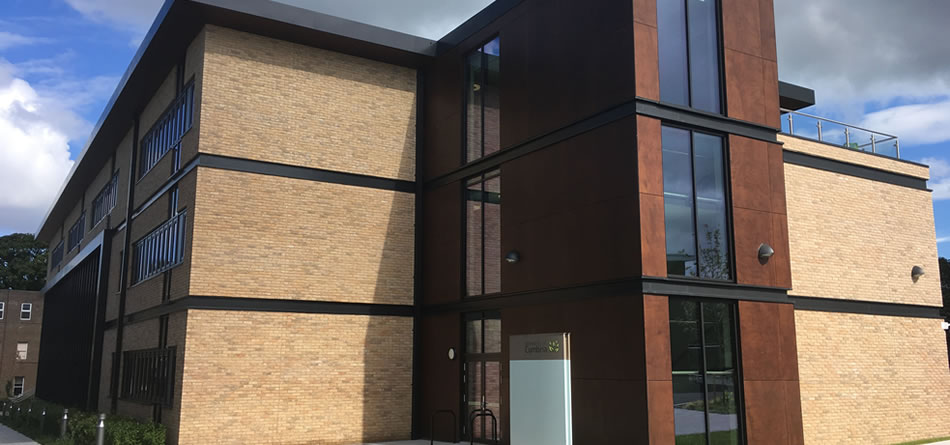
New Lancaster teaching block ready for work
August 11, 2017
The major development of a £9million teaching block on the Lancaster campus of the University of Cumbria is just weeks away from opening.
Featuring a 222 seat state of the art lecture theatre, class rooms and quiet study space the building is now ready to welcome new students in September.
The facility will be called the Sentamu Teaching Block in honour of the university’s chancellor, the Archbishop of York Dr John Sentamu.
It will be officially opened on 5 September by Edwin Booth, an honorary fellow of the University of Cumbria and chairman of the Lancashire Enterprise Partnership (LEP) which contributed £2.5million in Local Growth Funds towards the project.
Dr Michele Lawty-Jones, Director of the Lancashire Skills and Employment Hub, which is part of the LEP, said: “This state of the art teaching building offers first-class accommodation with modern teaching and learning facilities. It will play a key role in improving the skills of the county’s health and social care workforce, helping to transform the sector for years to come.
“This partnership with the University of Cumbria is a fantastic example of how the LEP uses its investment funds, as part of our ambitious strategic growth plan, to help realise the kind of projects that bring huge benefits to the county’s economy.
“I am delighted that we are now just a few weeks away from this fantastic new teaching block opening its doors to students.”
The new facility will train an additional 580 students, helping to meet the demand for health and social care services in Lancashire, which is increasing all the time due to an ageing population and improving life expectancy, with the result that some vacancies are getting harder and harder to fill.
During construction students and staff were consulted about the colour scheme, furniture and carpets and the development is already receiving praise as a sympathetic addition to the hill-top campus which has buildings dating back to 1880.
“The building looks amazing from outside, inside the colours we’ve used are very striking and I wanted it to be a focal point for students to really draw people in,” says project manager Nigel Beeden.
With numerous charging points for essential electrical devices, a chill-out area and a balcony overlooking playing fields with views towards Williamson Park and the Trough of Bowland, the development has been welcomed by students.
“The university has consulted with us throughout the project and we’ve been asked about the kind of furniture that should be used as well as the development of a break room for students,” Bethany Cutter, welfare officer for University of Cumbria Students Union said.
Academics too are eager to make use of the building which, together with the neighbouring annexe, will transform their ability to make the most of important class time for students.
“To be able to make use of a flexible teaching space where we can make full use of all our resources will make a major difference and ensure students get the most from each lecture,” principal lecturer Jan Ashbridge said.
The building itself has been constructed using the latest environmental standards:
Energy conservation – all lighting is energy efficient LED fitted with light level controls and occupancy sensors. Boilers and hand dryers meet strict efficiency standards.
Materials – all timber used certified under the Forest Stewardship Council, all carpets from at least 57% recycled material with 100% of paints supplied with an Environmental Product Declaration.
Water – all taps and toilets are low flush and low flush volume
Waste – at least 90% of construction waste was recycled or diverted from landfill with recycling bins provided throughout the building.
Renewable energy – 50 square metre of solar panels fitted to the roof generating clean electricity.
The official opening will also coincide with the creation of an exhibition of artefacts drawn together to mark the tenth anniversary of the formation of the University of Cumbria which will be housed in the new teaching block.
This development is the latest in a series of ambitious projects aimed at creating new accommodation for students and staff in Carlisle, Ambleside and Lancaster.
In Carlisle over £3.5 million has been invested in state-of-the-art science teaching and research laboratories at the Fusehill Street campus. The university has invested over £13million at the Ambleside campus since 2013 including £4.5million on bespoke student accommodation.
Video of the new building is available here:https://youtu.be/kLjj4qDcxWI
The University of Cumbria was formed ten years ago making it one of Britain’s youngest universities, however, its preceding history goes back over 150 years. Formed in 2007 from the union of Cumbria Institute of the Arts, St Martin’s College, Lancaster and UClan’s Cumbrian sites, the university now boasts vibrant campuses in Carlisle, Lancaster, Ambleside and London.
The university celebrates its tenth anniversary in 2017, a celebration that will reinforce its success, while supporting its sustainable and stable position within the region.
Since inception, the university has developed a strong academic reputation in education, healthcare and visual and performing arts. More recently the university diversified into broader academic areas with suite of science programmes. The new courses include biology, zoology and chemistry, all supported by a £3.5m investment in a new high-spec laboratory.
Friendly and compact campus communities foster supportive learning environments and easy access to award-winning student support means student satisfaction levels are high and rising. The university prides itself on its career-focused degrees. Six months after graduating, 9/10 of students find employment or continue further studies.
The university’s ranking in the 2014 Research Excellence Framework moved up 17 places, with a considerable increase in research recognised as ‘world-leading’ and ‘internationally excellent’. We have a vibrant research community with over 100 postgraduate research students registered at the University of Cumbria, all supervised by Cumbria academic staff. The final award is validated by Lancaster. We are seeking our own Research Degree Awarding Powers.
The Lancashire Enterprise Partnership has secured £251.1 million from the Government’s Local Growth Fund to support economic growth in the area through the Growth Deal.
The Lancashire Growth Deal aims to realise the growth potential of the whole of Lancashire, building on key local economic assets including the universities and colleges, the Enterprise Zone, the Preston, South Ribble and Lancashire City Deal and high-value business clusters across the county.
Over the lifetime of the deal (2015 – 2021) the Growth Deal is expected to create up to 8000 new jobs, 3000 new homes and attract £280m of additional public and private investment to Lancashire.
Latest Updates and Events

The impact of the Multiply programme on learners and businesses
Multiply, the numeracy skills programme funded by the Department for Education, continues to have a significant impact on learners and businesses alike. Feedback from Multiply learners who have...

‘Skills Bootcamps’ to bring more opportunities to retrain or switch career
‘Skills Bootcamps’ to bring more opportunities to retrain or switch career People in Lancashire will be able to retrain, improve their skills and even step into their dream...

Garstang students step into working life in Lancaster
Garstang Community Academy School students went to the Lancashire Careers Hub at Fraser House, a vibrant coworking space in Lancaster, to speak to people there working in the...